Improving Transfer in the Food Sector by Applying a Target Audience-Centered Approach—The Development of a Nonprofit Marketing Campaign Guide Based on a Case Study of the LAV Platform
Abstract
:1. Introduction
2. Aims and Objectives
3. Overview of the Project Design and Methodology
4. Phase I: Target Audience-Centered Marketing in a Nonprofit Environment
“A target audience centered organization is one that makes every effort to sense, serve, and satisfy the needs and wants of its multiple publics within the constraints of its budget”.[25]
- (1)
- The value proposition of your own enterprise’s product or service is seen as extremely desirable: Understand that what you consider the most important values may not satisfy the needs of the target audience. In other words, it might be necessary to adapt what you are offering to the target group by applying typical business terminology rather than using scientific language. Moreover, keep in mind that time usually is rare for businesses in the food sector. Long explanatory texts are likely to be skipped by the audience. Apply methods of market research to understand the target group and its needs. Use incentives that work in business. Contributing to fewer greenhouse gas emissions might not be as persuasive for managers as the opportunity to reduce costs.
- (2)
- You attribute failure to a lack of motivation or ignorance on the part of the target group: Understand that your product or service should fit the target audience rather than the target audience changing to fit the offering. If a tool fails, use market research to understand the reasons. Work with lead users or conduct interviews with potential users. Get them to assess your tool to better understand their needs and how these needs could be integrated into the valuable good you are offering.
- (3)
- You underestimate the importance of target-audience research: Understand that target-audience research delivers valuable information about attitudes and behavior, which enables you to offer something that provides necessary benefits. Target-audience research may also support you in prioritizing information and thus may facilitate decision-making.
- (4)
- You conflate marketing with promotion: Understand that the marketing challenge is not only to improve promotional activities, such as issuing a better brochure, placing more ads or writing more press releases. The challenge is to adapt the whole marketing mix (e.g., product features, prices, distribution channels) to the target audience in order to satisfy their needs.
- (5)
- You use a single “best” marketing strategy rather than approaching each market segment with specific strategies: Markets are not monolithic, as the target audience may include different segments that all need to be accounted for in the marketing mix. This may, for example, involve the usage of different languages for diverse segments of the target audience or the need for different levels of comprehensiveness.
- (6)
- You underestimate the effect of generic competition and fail to provide incentives for the target group to its change behavior: Support tools for the food sector have a lot of competition, which is not limited to other tools having similar targets. The largest competitor is the daily work routine of food businesses. Understand that time in companies is often a rare commodity. Hence, managers may not have the opportunity to take the time to learn how a tool works. Find strategies to address this by designing tools that are as easy to use as possible, by providing a support hotline, or by expanding your portfolio with other beneficial goods. For example, instead of just providing an online tool, offer a product service system (PSS) by integrating the optional service of a consultant to your portfolio or by offering webinars.
5. Phase II: The “Developing and Marketing the LAV Platform” Case Study
5.1. Methods Applied in the Case Study
5.2. Implementation of the Case Study
5.2.1. Research and Development
- Customized content for different target groups (producers, which were further classified according to sector meat and fish, dairy, bread and bakery, fruits and vegetables, and other producers; the retail sector; and the hospitality sector, divided into restaurants and public catering).
- Specific target-group language addressing the management and top staff of companies (i.e., avoiding scientific jargon).
- User-friendly navigation with visual aids, which allows for a simple and efficient search for results.
- A clear structure to reduce the complexity of the information provided (categorization of tools according to topic analysis and planning, raising awareness, measuring and monitoring, measures, and benchmarks and best practices as well as by target group). This allows the platform to specifically offer the target group only those solutions they require from the toolbox. In order to achieve this goal, the main navigation should be structured according to the different stages of the supply chain (producers, retail, and the hospitality sector) and the different sectors for each stage. For example, this ensures that a baker will only be shown tools applicable for bakers and that caterers will find only tools useful for caterers.
5.2.2. Pretesting
5.2.3. Implementation and Transfer
5.2.4. Monitoring
5.3. Conclusions Drawn from the Case Study
- SMEs are interested in fighting food waste. Their motivation is based on economic considerations.
- SME project partners have the will to participate. However, they have few time resources. Surveys were often only filled in by the contact person after sending a reminder or after personal communication via telephone. Moreover, guided expert interviews revealed more detailed information on opportunities for improvement than structured surveys.
- Personal communication with the contact person via telephone is important to establish a level of trust and to increase the commitment of partners.
- SMEs have limited time resources and consider additional consulting services useful to counteract food waste.
- Participatory methods are useful for gaining information on the needs of the target group. The research uncovered information on: (a) the functionality, layout and design of the platform; (b) the required content of the toolbox; (c) the required segmentation of the food sector; and (d) the transfer channels applied by the segments.
- Each segment of the target group wants to be addressed separately. General solutions are perceived as providing less benefit than segment-specific solutions.
- Pretesting of the platform is useful for receiving feedback on further opportunities for optimization (e.g., SMEs wished to have more tools in the German language).
- The promotional activities determined in the transfer concept lead to an increased awareness of the platform.
- Evaluating web traffic results in valuable information on the success of the transfer concept.
- The integration of multiplier organizations in the transfer process is useful, as they are perceived by the target group as a reliable provider of information.
6. Phase III: A Marketing Campaign Guide for Nonprofits Targeting the Development and Promotion of Support Tools for the Food Sector
7. Discussion
8. Conclusions, Limitations and the Need for Further Research
Acknowledgments
Author Contributions
Conflicts of Interest
References
- Kranert, M.; Hafner, G.; Barabosz, J.; Schneider, F.; Lebersorger, S.; Scherhaufer, S.; Schuller, H.; Leverenz, D. Determination of Discarded Food and Proposals for a Minimization of Food Wastage in Germany: Abridged Version. 2012. University Stuttgart Institute for Sanitary Engineering, Water, Quality and Solid Waste Management (ISWA). Available online: http://www.bmelv.de/SharedDocs/Downloads/EN/Food/Studie_Lebensmittelabfaelle_Kurzfassung.pdf?__blob=publicationFile (accessed on 16 February 2017).
- FAO. Food Wastage Footprint: Impacts on Natural Resources; Summary Report; FAO, 2013; Available online: http://www.fao.org/docrep/018/i3347e/i3347e.pdf (accessed on 16 February 2017).
- Beretta, C.; Stoessel, F.; Baier, U.; Hellweg, S. Quantifying food losses and the potential for reduction in Switzerland. Waste Manag. Res. 2013, 33, 764–773. [Google Scholar] [CrossRef] [PubMed]
- Derqui, B.; Fayos, T.; Fernandez, V. Towards a More Sustainable Food Supply Chain: Opening up Invisible Waste in Food Service. Sustainability 2016, 8, 693. [Google Scholar] [CrossRef]
- Eriksson, M.; Strid, I.; Hansson, P. Waste of organic and conventional meat and dairy products—A case study from Swedish retail. Resour. Conserv. Recycl. 2014, 83, 44–52. [Google Scholar] [CrossRef]
- Garrone, P.; Melacini, M.; Perego, A. Opening the black box of food waste reduction. Food Policy 2014, 46, 129–139. [Google Scholar] [CrossRef]
- Garrone, P.; Melacini, M.; Perego, A.; Sert, S. Reducing food waste in food manufacturing companies. J. Clean. Prod. 2016, 137, 1076–1085. [Google Scholar] [CrossRef]
- Göbel, C.; Langen, N.; Blumenthal, A.; Teitscheid, P.; Ritter, G. Cutting Food Waste through Cooperation along the Food Supply Chain. Sustainability 2015, 7, 1429–1445. [Google Scholar] [CrossRef]
- Halloran, A.; Clement, J.; Kornum, N.; Bucatariu, C.; Magid, J. Addressing food waste reduction in Denmark. Food Policy 2014, 49, 294–301. [Google Scholar] [CrossRef]
- WRAP (Waste and Resources Action Programme). Available online: http://www.wrap.org.uk (accessed on 16 February 2017).
- Hyde, K.; Smith, A.; Smith, M.; Henningsson, S. The challenge of waste minimisation in the food and drink industry: A demonstration project in East Anglia, UK. J. Clean. Prod. 2001, 9, 57–64. [Google Scholar] [CrossRef]
- Jepsen, D.; Vollmer, A.; Eberle, U.; Fels, J.; Schomerus, T. Entwicklung von Instrumenten zur Vermeidung von Lebensmittelabfällen. 2014. Umweltbundesamt. Available online: https://www.umweltbundesamt.de/sites/default/files/medien/378/dokumente/zusammenfassung_entwicklung_von_instrumenten_zur_vermeidung_von_lebensmitteabfaellen_0.pdf (accessed on 16 February 2017).
- Katajajuuri, J.; Silvennoinen, K.; Hartikainen, H.; Heikkilä, L.; Reinikainen, A. Food waste in the Finnish food chain. J. Clean. Prod. 2014, 73, 322–329. [Google Scholar] [CrossRef]
- Kreyenschmidt, J.; Albrecht, A.; Braun, C.; Herbert, U.; Mack, M.; Roissant, S.; Ritter, G.; Teitscheid, P.; Ilg, Y. Food Waste in der Fleisch verarbetenden Kette: Um Lebensmittetverluste zu minimieren, sind Handlungen entlang der Kette Fleisch notwendig. Fleischwirtschaft 2013, 93, 57–63. [Google Scholar]
- Mena, C.; Adenso-Diaz, B.; Yurt, O. The causes of food waste in the supplier-retailer interface: Evidences from the UK and Spain. Resour. Conserv. Recycl. 2011, 2011, 648–658. [Google Scholar] [CrossRef]
- Parry, A.; Bleazard, P.; Okawa, K. Preventing Food Waste: Case Studies of Japan and the United Kingdom; OECD Food, Agriculture and Fisheries Papers, 2015; Available online: http://dx.doi.org/10.1787/5js4w29cf0f7-en (accessed on 16 February 2017).
- Parry, A.; James, K.; LeRoux, S. Strategies to Achieve Economic and Environmental Gains by Reducing Food Waste: WRAP (Waste & Resources Action Programme). 2015. Available online: http://newclimateeconomy.report/2014/wp-content/uploads/sites/2/2015/02/WRAP-NCE_Economic-environmental-gains-food-waste.pdf (accessed on 16 February 2017).
- Schneider, F. Review of food waste prevention on an international level. Waste Resour. Manag. 2013, 166, 187–203. [Google Scholar] [CrossRef]
- Sonnino, R.; McWilliam, S. Food waste, catering practices and public procurement: A case study of hospital food systems in Wales. Food Policy 2011, 36, 823–829. [Google Scholar] [CrossRef]
- Strotmann, C.; Göbel, C.; Friedrich, S.; Kreyenschmidt, J.; Ritter, G.; Teitscheid, P. A Participatory Approach to Minimizing Food Waste in the Food Industry—A Manual for Managers. Sustainability 2017, 9, 66. [Google Scholar] [CrossRef]
- Williams, P.; Kokkinakos, M.; Walton, K. Definitions and causes of hospital food waste. Food Serv. Technol. 2003, 3, 37–39. [Google Scholar] [CrossRef]
- World Resources Institute. Available online: http://www.wri.org/ (accessed on 16 February 2017).
- United against Waste—Gemeinsam Gegen Lebensmittelverschwendung. Available online: http://www.united-against-waste.de/ (accessed on 16 February 2017).
- EPA National Waste Prevention Programm. Available online: http://www.epa.ie/pubs/reports/waste/stopfoodwaste/ (accessed on 16 February 2017).
- Andreasen, A.R.; Kotler, P.R. Strategic Marketing for Non-Profit Organisations: Pearson New International Edition, 7th ed.; United States Edition; Pearson: Harlow, UK, 2014. [Google Scholar]
- Dolnicar, S.; Lazarevski, K. Marketing in non-profit organizations: an international perspective. Int. Mark. Rev. 2009, 26, 275–291. [Google Scholar] [CrossRef]
- Meffert, H.; Burmann, C.; Kirchgeorg, M. Marketing: Grundlagen Marktorientierter Unternehmensführung Konzepte—Instrumente—Praxisbeispiele, 12th ed.; Springer Fachmedien Wiesbaden: Wiesbaden, Germany, 2015. [Google Scholar]
- Meffert, H.; Bruhn, M.; Hadwich, K. Dienstleistungsmarketing: Grundlagen—Konzepte—Methoden, 8th ed.; Springer Fachmedien Wiesbaden: Wiesbaden, Germany, 2015. [Google Scholar]
- Homburg, C.; Becker, J. Marktorientierte Unternehmensführung und Ihre Erfolgsauswirkungen. Eine Empirische Untersuchung. In Reihe: Wissenschaftliche Arbeitspapiere; Institut für Marktorientierte Unternehmensführung, Mannheim University: Mannheim, Germany, 2000. [Google Scholar]
- Aaker, D.A.; McLoughlin, D. Strategic Market Management; Wiley: Chichester, UK, 2008. [Google Scholar]
- Kotler, P.; Keller, K.L. Marketing Management, 12th ed.; Prentice-Hall: Upper Saddle River, NJ, USA, 2006. [Google Scholar]
- Vahs, D.; Brem, A. Innovation Management: From ideas to successful implementation. In Innovationsmanagement: Von der Idee zur erfolgreichen Vermarktung; Schäffer-Poeschel Verlag: Stuttgart, Germany, 2015. [Google Scholar]
- Cooper, R.G. How companies are reinventing their idea-to-launch methodologies: Next-generation Stage-Gate systems are proving more flexible, adaptive and scalable. Res. Technol. Manag. 2009, 52, 47–57. [Google Scholar]
- Institut für Nachhaltige Ernährung (iSuN). Gesamttabelle der Recherchierten Instrumente zur Vermeidung von Lebensmittelabfall innerhalb des Projektes “Verluste in der Lebensmittel-Branche: Forschungstransfer in die KMU-Praxis”. 2016. Available online: http://www.lebensmittel-abfall-vermeiden.de/wp-content/uploads/2017/01/170123_Gesamttabelle_Instrumente.pdf (accessed on 16 February 2017).
- Flügge, F. Entwicklung Eines Bewertungskonzeptes für Instrumente zur Vermeidung von Lebensmittelverlusten in der Lebensmittelwirtschaft. Bachelor’s Thesis, Münster University of Applied Sciences, Münster, Germany, 2015. [Google Scholar]
- Institut für Nachhaltige Ernährung (iSuN). LAV-Plattform: Lebensmittel-Abfall-Vermeiden. Available online: http://www.lebensmittel-abfall-vermeiden.de/ (accessed on 16 February 2017).
- Niepagenkemper, L. Transfer von Forschungsergebnissen in die Praxis: Entwicklung Eines Transferkonzeptes für die Vermeidung von Lebensmittelabfällen in Unternehmen der Außer-Haus-Gastronomie. Master’s Thesis, Münster University of Applied Sciences, Münster, Germany, 2015. [Google Scholar]
- Neuber, K. Entwicklung eines Branchenübergreifenden Transferkonzeptes für die Lebensmittelwirtschaft im Rahmen des Forschungsprojektes “Verluste in der Lebensmittelbranche vermeiden”. Master’s Thesis, Münster University of Applied Sciences, Münster, Germany, 2016. [Google Scholar]
- Korell, M.; Schat, H. Entwicklung eines Transfermodells. In Transfer von Forschungsergebnissen in Die Industrielle Praxis: Konzepte, Beispiele, Handlungsempfehlungen; Zusammenfassung der Ergebnisse des Beispielhaften Transferprojekt ‘Mechatronik’; Fraunhofer Verlag: Stuttgart, Germany, 2013; pp. 12–36. [Google Scholar]
- Jaensch, M. Kommunikationsstrukturen in der Lebensmittelwirtschaft am Beispiel der Fleischwarenbranche und der Obst- und Gemüsebranche—Erarbeitung von Empfehlungen für ein Branchenbezogenes Transferkonzept zur Vermeidung von Lebensmittelabfällen in klein- und mittelständischen Unternehmen. Bachelor’s Thesis, Münster University of Applied Sciences, Münster, Germany, 2016. [Google Scholar]
- FoodDrinkEurope. Data & Trends European Food and Drink Industry 2014–2015; FoodDrinkEurope: Brussel, Belgium, 2015; Available online: https://www.wko.at/Content.Node/branchen/oe/Nahrungs--und-Genussmittelindustrie--Lebensmittelindustrie-/Data_and_Trends_2014-20152.pdf (accessed on 16 February 2017).
- BVE. Jahresbericht 2015–2016. Bundesvereinigung der Deutschen Ernährungsindustrie. Available online: http://www.bve-online.de/presse/infothek/publikationen-jahresbericht/jahresbericht-2016 (accessed on 16 February 2017).
- Kwak, W. Marketing Strategies of Non-Profit Organizations in Light of Value-Based Marketing; Wyższa Szkoła Biznesu—National-Louis University, 2011; Available online: http://hdl.handle.net/11199/468 (accessed on 16 February 2017).
- FoodSave. Available online: http://www.foodsave.org/ (accessed on 16 February 2017).
- Lean Path: Food Waste Prevention. Available online: http://www.leanpath.com/ (accessed on 16 February 2017).
- Love Food, Hate Waste (United Kingdom). Available online: http://ec.europa.eu/environment/waste/prevention/pdf/Lovefoodhatewaste_Factsheet.pdf (accessed on 16 February 2017).
- Zu gut für die Tonne. Available online: https://www.zugutfuerdietonne.de/ (accessed on 16 February 2017).
- WRAP (Waste and Resources Action Programme). Tool: diagnostics spreadsheet template: Problem Definition or Diagnostics. 2016. Available online: www.wrap.org.uk/content/problem-definition-spreadsheet-template-v1 (accessed on 16 February 2017).
- Secondary Packaging Optimisation: Packaging Waste Prevention—Digest. Available online: http://www.wrap.org.uk/content/food-waste-prevention-digests-secondary-packaging (accessed on 16 February 2017).
- Reducing Waste in the Fresh Meat Sector. Available online: http://www.wrap.org.uk/sites/files/wrap/Meat_Sector_supply_chain_sheet.pdf (accessed on 16 February 2017).
- Food Waste Tracking Sheet. Available online: http://www.wrap.org.uk/sites/files/wrap/Food_Waste_Tracking_Sheet_v1.1_0_050115.pdf (accessed on 16 February 2017).
- WRAP (Waste and Resources Action Programme). Grocery Sector Map: WRAP (Waste and Resources Action Programme). 2014. Available online: http://www.wrap.org.uk/sites/files/wrap/Sector%20map%2001%2008%2014.pdf (accessed on 16 February 2017).
- REFRESH. Available online: http://eu-refresh.org/ (accessed on 16 February 2017).
- ReFoWas: Reduce Food Waste. Available online: http://refowas.de/ (accessed on 16 February 2017).
- Betz, A.; Buchli, J.; Göbel, C.; Müller, C. Food waste in the Swiss food service industry—Magnitude and potential for reduction. Waste Manag. 2015, 2015, 218–226. [Google Scholar] [CrossRef] [PubMed]
- Engström, R.; Carlsson-Kanyama, A. Food losses in food service institutions: Examples from Sweden. Food Policy 2004, 29, 203–213. [Google Scholar] [CrossRef]
- Teitscheid, P.; Strotmann, C.; Blumenthal, A.; Schreiner, L.; Aich, E. Forschungsbericht zum INTERREG Projekt “Nachhaltig Gesund/Duurzaam Gezond”. 2015. Available online: https://www.fh-muenster.de/isun/downloads/studie-lebensmittelverschwendung/Forschungsbericht_NachhaltigGesund_Deutsch_07-05_latest.pdf (accessed on 16 February 2017).
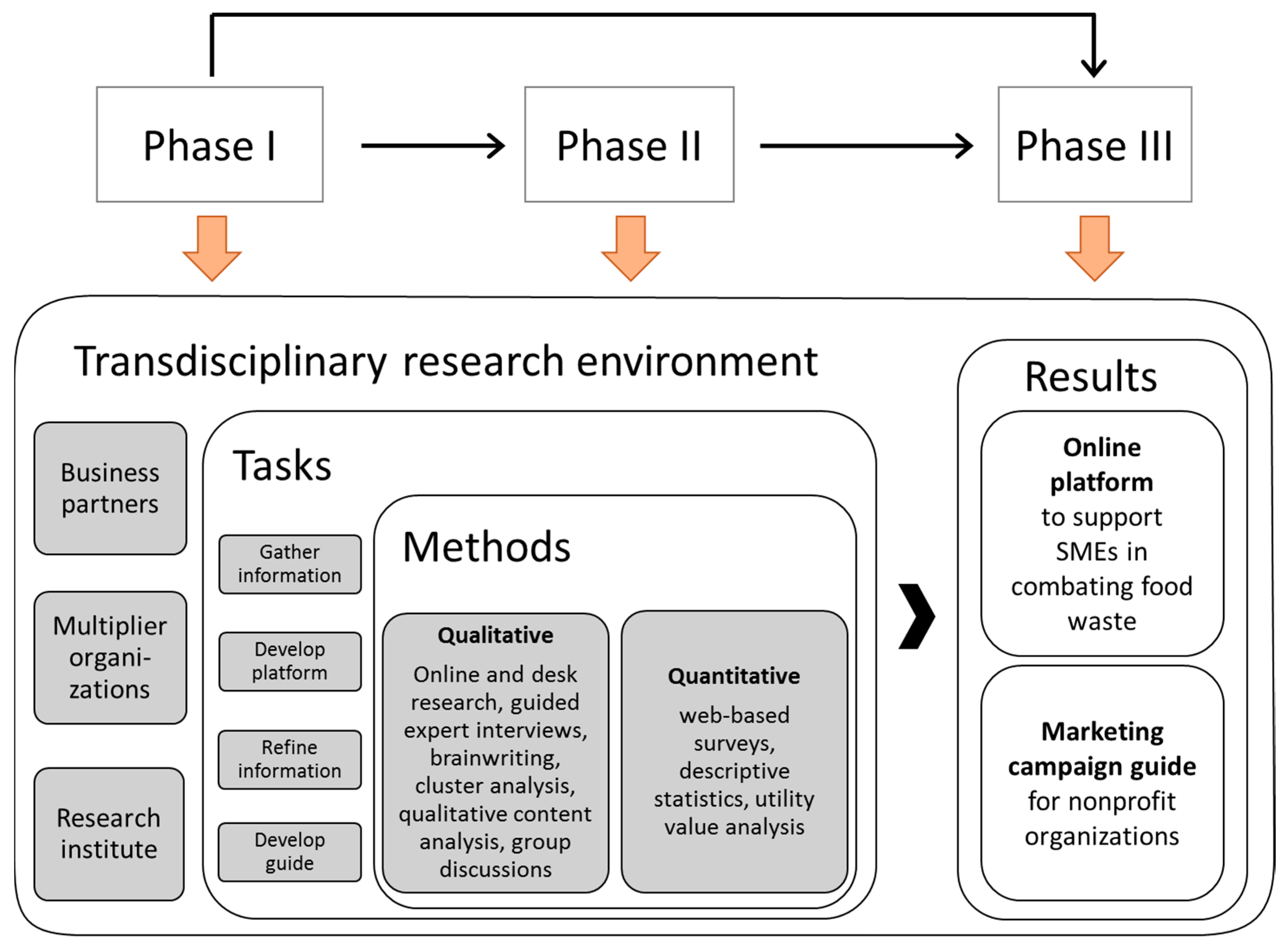
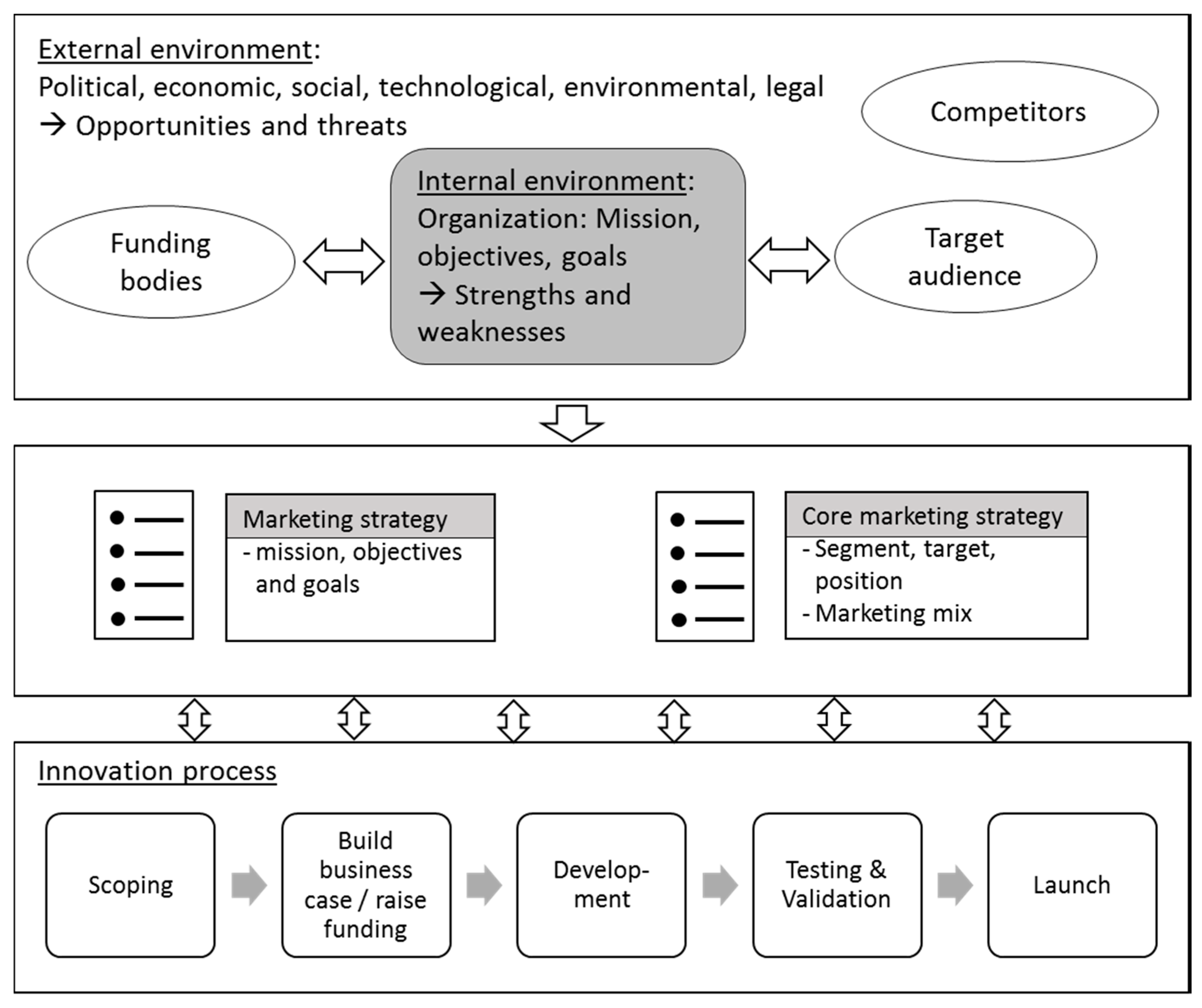
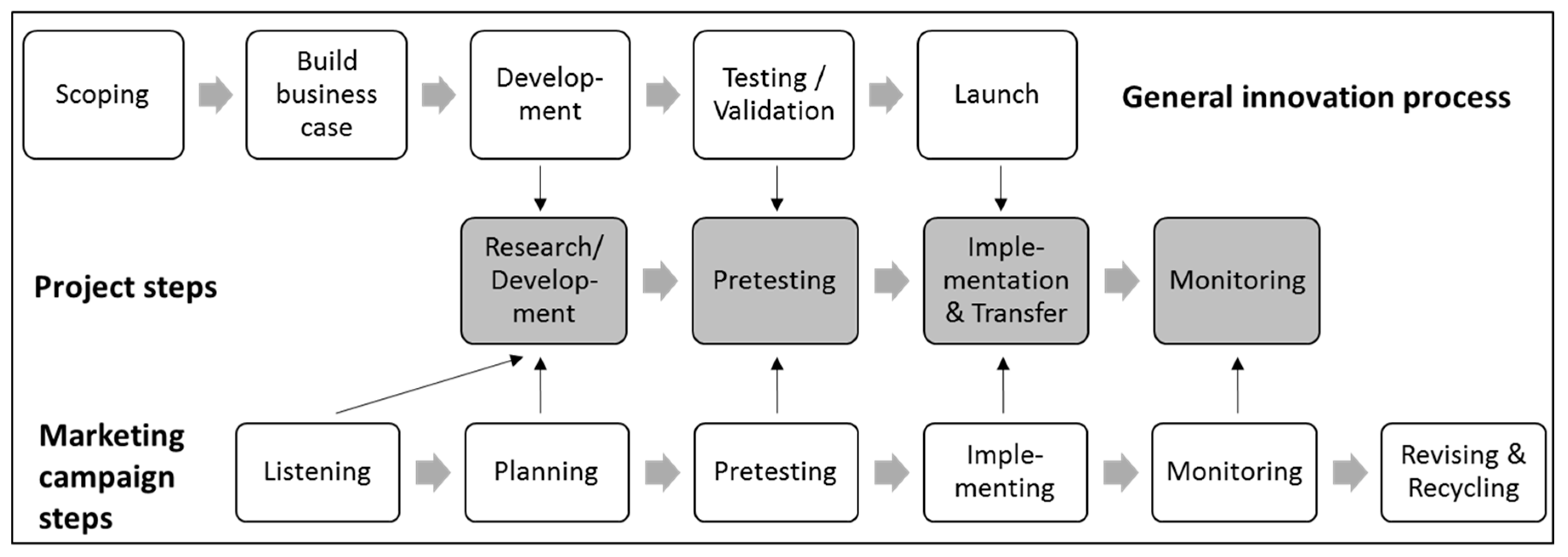
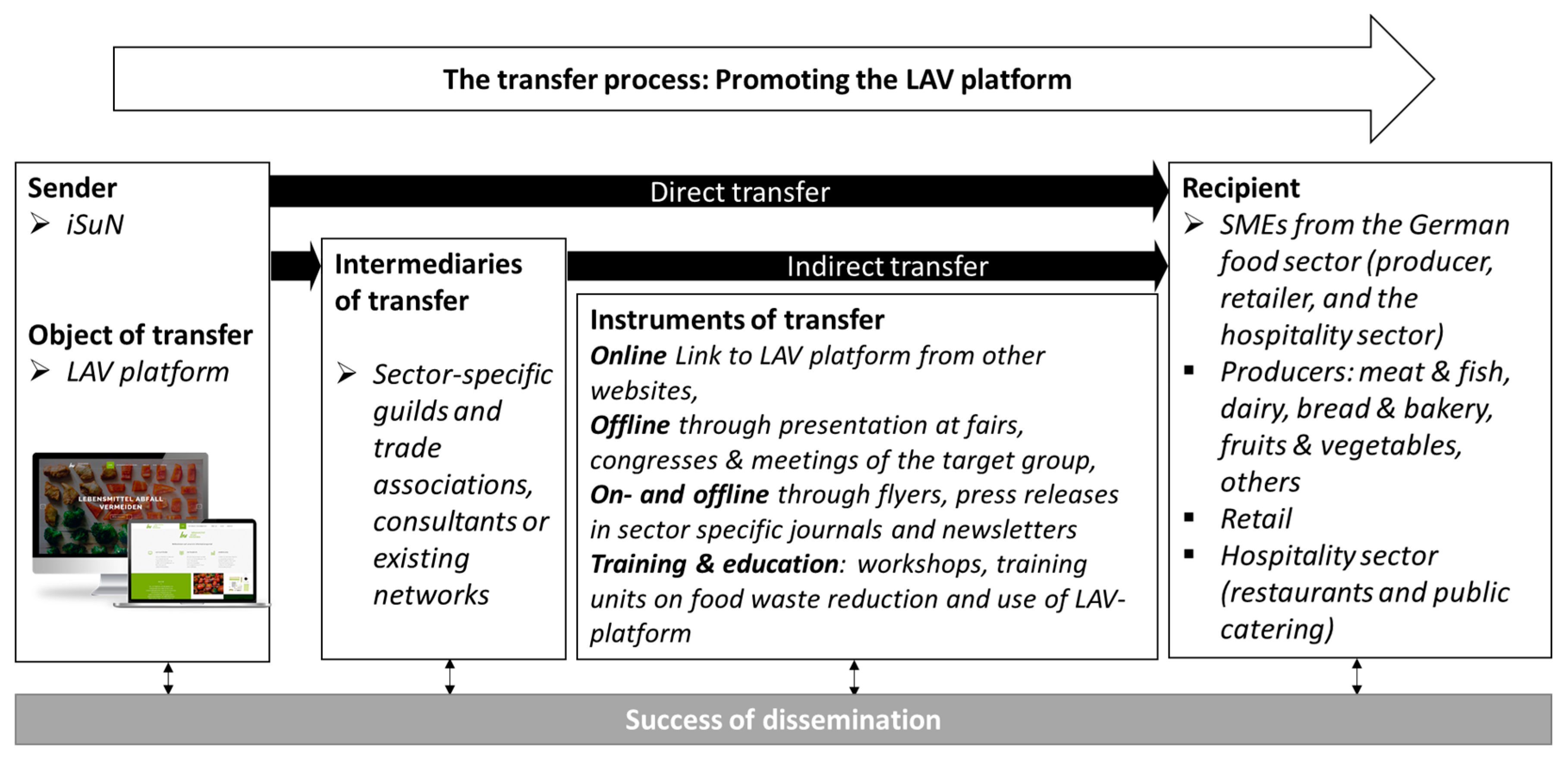
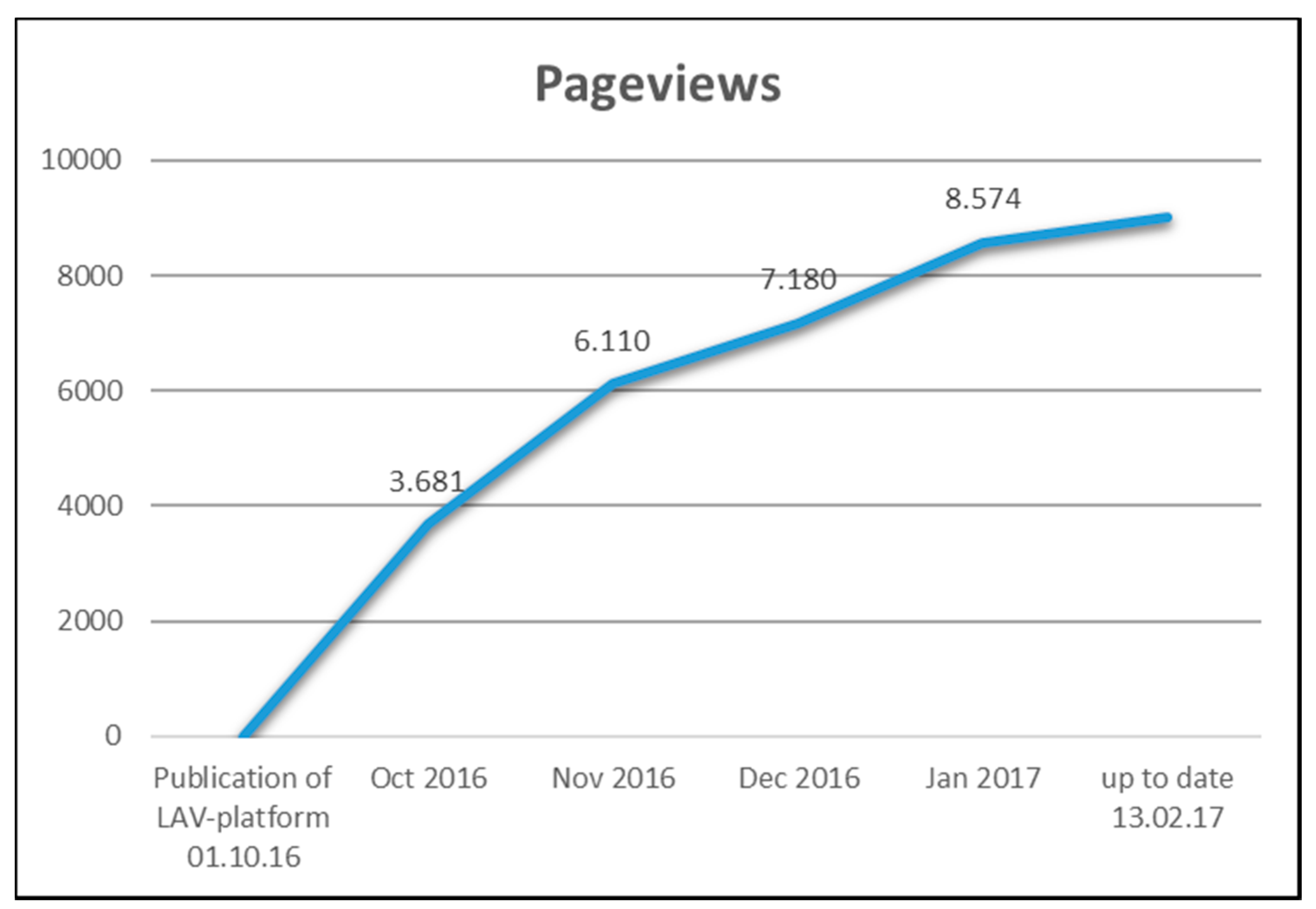
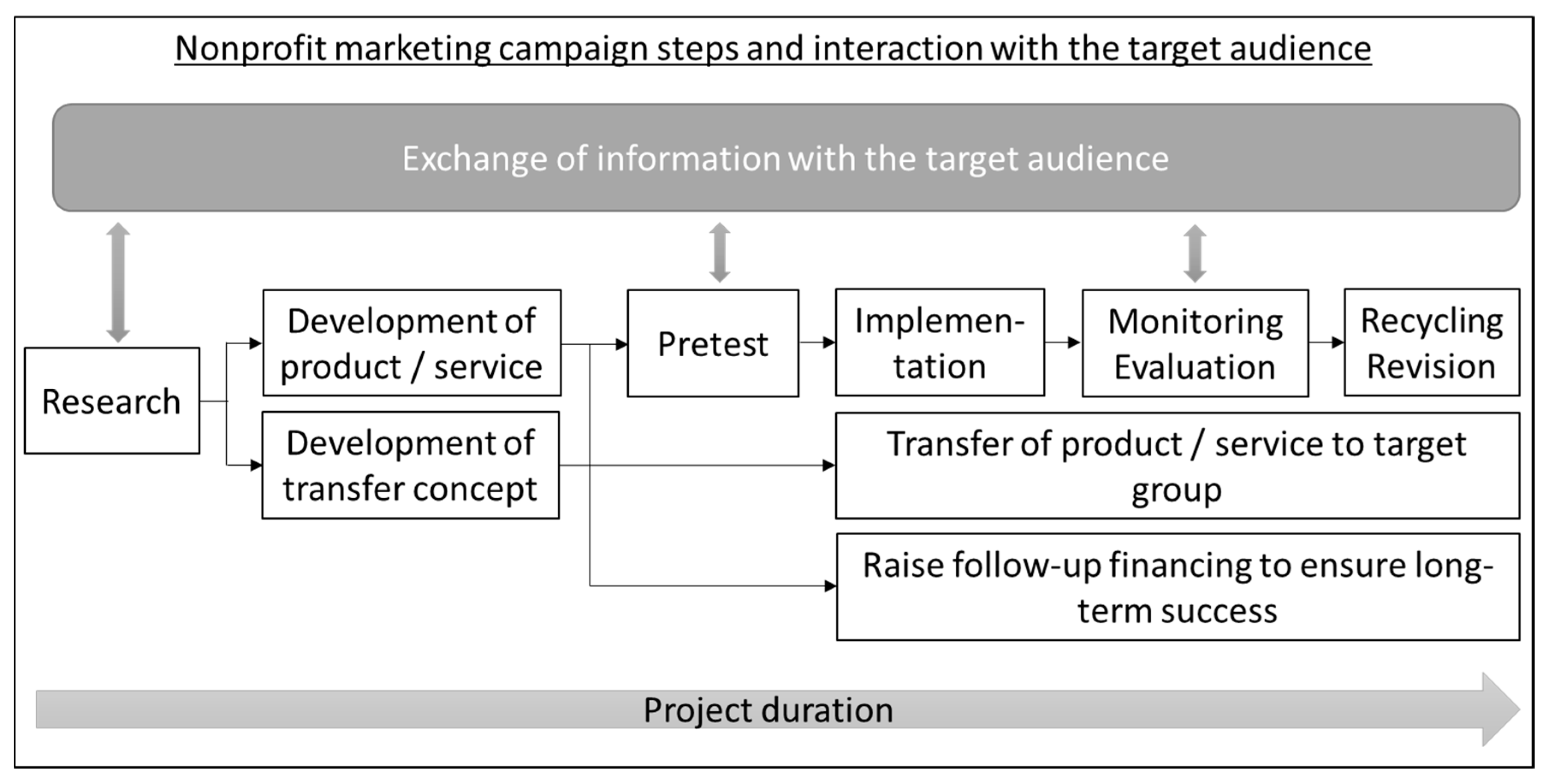
| Project Phase | Research Questions | Tasks/Milestones | Methods Applied |
|---|---|---|---|
| Understanding target audience-centered marketing and the idiosyncrasies of the nonprofit market | What are the characteristics of target audience-centered marketing? What are the specific challenges for a nonprofit’s marketing campaign? | Gather information on marketing management and refine relevant information for nonprofits | Online and desk research |
| Case study: Developing an online platform to support SMEs in the food sector in their effort to reduce food waste | How should the online platform be designed to reach maximum acceptance by the target group? How should the online platform be promoted in order to achieve maximum visibility? | Research (gather information on user needs and on existing tools; determine transfer channels and supporting and inhibiting factors of transfer) Develop (determine product specifications, prioritize tools and information, determine transfer concept) Pretest prototype of platform Implement and monitor (analyze opportunities for optimization after publishing of platform) Transfer platform to public | Online and desk research Telephone interviews (semi-structured with closed and open-ended questions) Web-based surveys (structured with closed and open-ended questions) Guided expert interviews Qualitative content analysis Brainwriting, cluster analysis Group discussion Prioritization based on utility analysis Cost analysis (to compare wants vs. costs) Descriptive analysis of website traffic |
| Developing a guide for nonprofits that supports them in successfully developing and transferring support tools for the food sector | What are the relevant elements of target audience-centered marketing for the marketing campaign guide? What are the relevant experiences from the case study that should be integrated into the marketing campaign guide? | Determine implications from Phases I and II Develop marketing campaign guide | Group discussion Online and desk research |
| Step | Participating Organizations | Reasons for Participation |
|---|---|---|
| Conducting research related to the needs of the target audience | 12 SMEs (project partners from the food sector) 6 multiplier organizations (project partners) | Gaining knowledge about the target group to adapt the LAV platform to their needs and wants related to:
|
| Pretesting the platform | 12 SMEs (project partners) 68 other SMEs 6 multiplier organizations (project partners) | Gaining knowledge on the application of the LAV platform under real working conditions to identify:
|
| Conducting research related to the transfer concept | 24 SMEs (project partners and others) 11 multiplier organizations (project partners and others) | Understanding the process of transfer from the research institute to the SME sector of the food industry and the hospitality sector, specifically:
|
| Criterion | Importance ∑100% | Rating Scale for Tools |
|---|---|---|
| German language | 14% | Yes/No |
| Structure and design | 16% | 5-point-scale (1 = needs development; 5 = very effective) |
| Time required to understand tool | 16% | 5-point-scale (1 = very long; 5 = very short) |
| Relevance of tool for management only or also other staff | 12% | Yes/No |
| Registration requirement to use tool | 9% | Yes/No |
| Cost of tool | 10% | Yes/No |
| Usability of tool in printed format | 11% | Yes/No |
| Industry specificity of tool | 12% | Yes/No |
| Supporting Factors |
| Integration of reliable industry representatives (sector-specific guilds and trade associations), consultants, and existing networks from the various sectors as opinion leaders into the communication process Concise, precise information on the LAV platform in newsletters and other media available through multiplier organizations Ads in various professional magazines catering to different sectors Presentation of the LAV platform at industry-specific events, such as specific exhibitions Customization of messaging for each sector by adapting the information provided specifically to each group Emphasis on the utility and benefits of the LAV platform Provision of easy access to the platform, especially by integrating a link to the LAV platform in online ads |
| Inhibiting Factors |
| Lack of time An overflow of information via email Too many emails from different and unknown senders Email lost in spam folders Lack of interest in the topic of food waste reduction/assumption of the topic as irrelevant Offline advertising for an online medium Target group addressed too generally |
| What? Field of Action | How? Instrument/Procedure | Where? Process | Who? Person in Charge | Who? Person Involved | When? Frequency/Schedule | Remarks | |
|---|---|---|---|---|---|---|---|
| 1 | Raising Awareness | Video clip | Store | Store manager | Other employees of store | Once by July 2016 | Can directly be started |
| 2 | Measurement | Measurement of plate waste | Dishwashing area | Store manager | Other employees of store | One week measurement by July 2016 | Requires planning and instruction of employees |
| 3 | Procedures | Use food waste calculator for analysis of results | Management | CEO | Store-manager | By August 2016 | Requires results of measurement |
| Sector | Analysis and Planning | Raising Awareness | Measuring and Monitoring | Measures | Benchmarks and Best Practices |
|---|---|---|---|---|---|
| Producer | |||||
| Meat and Fish | 13 | 4 | 4 | 8 | 5 |
| Dairy | 9 | 6 | 2 | 4 | 2 |
| Fruits and Vegetables | 9 | 4 | 2 | 4 | 5 |
| Bread and Bakery | 9 | 4 | 6 | 10 | 6 |
| Others | 8 | 4 | 2 | 6 | 3 |
| Retail | |||||
| Retail | 9 | 4 | 2 | 4 | 8 |
| Hospitality sector | |||||
| Restaurants | 8 | 10 | 12 | 21 | 12 |
| Public Catering | 9 | 11 | 17 | 26 | 9 |
| Marketing Campaign Steps |
|---|
| Research |
| Intention: Conducting formative research means listening to the target audience in order to understand audience needs, wants, values or motivations. Moreover, information on market segmentation is gathered. The most common reason for failure is not properly listening to the target group. Meaning: The target group of SMEs in the food sector is quite diverse, as it covers a whole range of companies along the food value chain. Producers have needs and wants that are different from those of retailers or companies from the hospitality sector. Market research is a method to obtain the information required. If expert interviews are used, pretests should first ensure that the interviewer knows how to ask the questions and that they are easy to understand. The same applies to web-based surveys. Suggested methods:
|
| Development of product/service and transfer concept |
| Intention: This step is intended to translate the information gathered in the preceding step into concrete characteristics of the marketing mix. This means identifying the benefits of the proposed offering, and defining goals, timelines, and responsibilities. Moreover, the information concerning transfer channels is analyzed, and activities related to the transfer concept are defined. Meaning: Segmenting SMEs of the food sector may result in groups such as bread and bakery, dairy, meat and fish, confectionary, or fruits and vegetables. The hospitality sector may be split into restaurants and public catering. Moreover, it is necessary to further define which group of employees should be addressed. Blue-collar workers may have different needs and wants than white-collar workers do. Any products or services offered need to be tailored to the specific target segment. A support tool might be web-based or a printed brochure or checklist, which addresses the fact that blue-collar workers might not have the same regular access to computers that white-collar workers do. For this reason, the tools for each group need to be designed accordingly. The challenge of this step is therefore to develop a tool which can be made for the whole target group but also specifically addresses the needs of each member of the segments. Just as different segments of a target audience request different value propositions of the product or service, the transfer concept must require different transfer activities. In the food sector, there are several different transfer channels: intermediaries, such as segment-specific guilds and trade associations, consultants, and existing networks, or different professional magazines and the trade press. In the research phase, it is also important to identify the transfer channels used by various segments of the target audience. Methods:
|
| Pretesting |
| Intention: Pretesting key elements of the product or service is necessary to assure the target group reacts in the desired way. By pretesting, marketers gain valuable insights into how the product or service is used and judged by the target group. Pretesting assesses whether the marketers have been capable of transforming the information gained through market research into the proposed benefit. It serves as an initial evaluation of the success of the planning process and detects the discrepancies between that what the marketer intended to develop and what has actually been carried out. Meaning: A prototype of the support tools should to be tested by the targeted segments. Do the users feel the tool addresses their needs, or do they perceive it as “not made for me”? The pretesting step shows if the users understand how to apply the supporting tool. Further, it reveals if the user likes the content and the way it is designed and if it leads to the desired result. Pretesting should be related to the layout as well as to the content of the tool. Since evaluating the content may require more time than evaluating the layout, it is useful to separate the assessment into two parts. If the tester only has limited time, he might be deterred by a long testing process. Splitting the test allows him to do the testing step-by-step, which will increase the chance that the testing is actually completed. Moreover, it is important to do a pretest of the pretesting procedure with a selected member of the target group. This helps in designing the pretest, including its introductory text, to be efficient and clearly understood. Methods:
|
| Implementation |
| Intention: In the implementation step, the campaign is launched after the product or service has been improved according to the results of the pretesting step. The product/service is distributed to the target group. Meaning: This is the point in time when the support tool is actually published and available for the target group. Therefore, it is important that the pretesting (and refining) step is finished. Once the promotion campaign, i.e., the transfer activities, has been started, the target group is going to access the tool. Therefore, the product should include all the intended benefits. If the tool includes a service hotline, there must be sufficient personnel to staff it. Brochures need to be printed, and online tools must be ready to use. In addition, monitoring activities should be initiated in order to assess the campaign’s success. Methods:
|
| Monitoring and Evaluation |
| Intention: This step is designed to monitor if the campaign works in the desired way. It reveals whether there is anything unexpected happening on the market, such as the launch of a competing product/service or a new political trend. Moreover, this step verifies if the tool satisfies the needs of the target audience, i.e., if its benefits are perceived in the desired way and if the promotion campaign reaches the target audience. Meaning: Nonprofit organizations offering support tools for SMEs from the food sector rely on feedback from businesses. Since the tools are often developed by non-practitioners, receiving feedback is essential to evaluate the success of the tool and its usefulness in daily work routines. Since nonprofits often cannot evaluate the success of their product/service in terms of sales figures or generated revenues (as what they are offering is provided free of charge), they need to establish other measures of oversight. This means relying on non-financial indicators, such as measuring the performance of the target audience or stakeholders. Target audience performance may be assessed by such indicators as the percentage of users who would reuse the product/service, who would recommend the tool to others, or who fall into the categories of very dissatisfied, dissatisfied, neutral, satisfied, and very satisfied [31]. The food sector is highly competitive for and among SMEs. The practicality of the tools offered should be evaluated under real working conditions, when time and staff resources are low. As opposed to for-profits, nonprofits that are providing something free of charge do not have a customer database. It is not clear who exactly is the person in the SME who ultimately uses the tool. There is no contact person to address to gather feedback. Therefore, it is useful to acquire business partners in all targeted segments who are willing to use and assess the tools. The evaluation can be separated into two parts: The first concerns layout, design, and content of the tool; and the second is related to the transfer concept. This means analyzing if the target audience could be (or has already been) reached by transfer activities. Methods:
|
| Revision and Recycling |
| Intention: The revision of the product/service is a consequence of following the monitoring and evaluation step. This step is designed to reveal whether the target audience did not understand the benefits provided by the tool, or it was unable to be reached at all. If this is the case, the marketing campaign needs to start again at the research step to improve the situation. It might also be that one segment of the target group could be reached, while others were not. In this case, it might be necessary to adapt the product/service to the special needs of this segment (including a new pretest) or to revise and improve transfer activities. Meaning: It is important that project managers integrate the revision and recycling step into their project schedule. This is especially true if funding has only been granted for a limited time; project managers need to realize that they should have the financial and personnel resources to react to the results of the revision phase. In other words, if the product/service launched by the nonprofit organization is a website, the task of improving it after the evaluation should be integrated into the web designer’s contract, or a budget for improvements must be considered in the financial plan of the project. Methods:
|
| Transfer of Product/Service to the Target Group |
| Intention: Transfer activities are put in place according to a transfer concept. This is set up during the development phase, based on analyzing the target group during the research phase. It integrates the supporting factors of transfer and works to mitigate or avoid inhibiting factors. Transfer attempts to promote the product/service to the target group. Meaning: There are several support tools available on the Internet for free. Moreover, it is not clear for every SME what the advantages of any given support tool may be. Therefore, it is important to grab the target audience’s attention regarding the new product/service and to convince potential users to test it. As a result, transfer activities have a major influence on the success of a tool. Nonprofits need to identify any and all actors on the market who could support their promotional activities. This “indirect transfer”, which uses intermediaries, has the advantage that SMEs know these intermediaries and they trust them to provide reliable and relevant information. For the food sector in Germany, sector-specific guilds and trade associations, well-known industry-specific consultants, and existing professional and social networks were all identified as relevant intermediaries. Methods:
|
| Raising Follow-Up Financing |
| Intention: Raising follow-up financing is important to ensure the long-term success of the product/service. Meaning: Follow-up financing ensures updating of tool content, or technical maintenance of web-based tools. It allows permanent adaption to changing markets (e.g., new political decisions related to prevention of food waste) and the continuing of transfer activities. Methods:
|
© 2017 by the authors. Licensee MDPI, Basel, Switzerland. This article is an open access article distributed under the terms and conditions of the Creative Commons Attribution (CC BY) license (http://creativecommons.org/licenses/by/4.0/).
Share and Cite
Strotmann, C.; Niepagenkemper, L.; Göbel, C.; Flügge, F.; Friedrich, S.; Kreyenschmidt, J.; Ritter, G. Improving Transfer in the Food Sector by Applying a Target Audience-Centered Approach—The Development of a Nonprofit Marketing Campaign Guide Based on a Case Study of the LAV Platform. Sustainability 2017, 9, 512. https://doi.org/10.3390/su9040512
Strotmann C, Niepagenkemper L, Göbel C, Flügge F, Friedrich S, Kreyenschmidt J, Ritter G. Improving Transfer in the Food Sector by Applying a Target Audience-Centered Approach—The Development of a Nonprofit Marketing Campaign Guide Based on a Case Study of the LAV Platform. Sustainability. 2017; 9(4):512. https://doi.org/10.3390/su9040512
Chicago/Turabian StyleStrotmann, Christina, Linda Niepagenkemper, Christine Göbel, Fara Flügge, Silke Friedrich, Judith Kreyenschmidt, and Guido Ritter. 2017. "Improving Transfer in the Food Sector by Applying a Target Audience-Centered Approach—The Development of a Nonprofit Marketing Campaign Guide Based on a Case Study of the LAV Platform" Sustainability 9, no. 4: 512. https://doi.org/10.3390/su9040512






